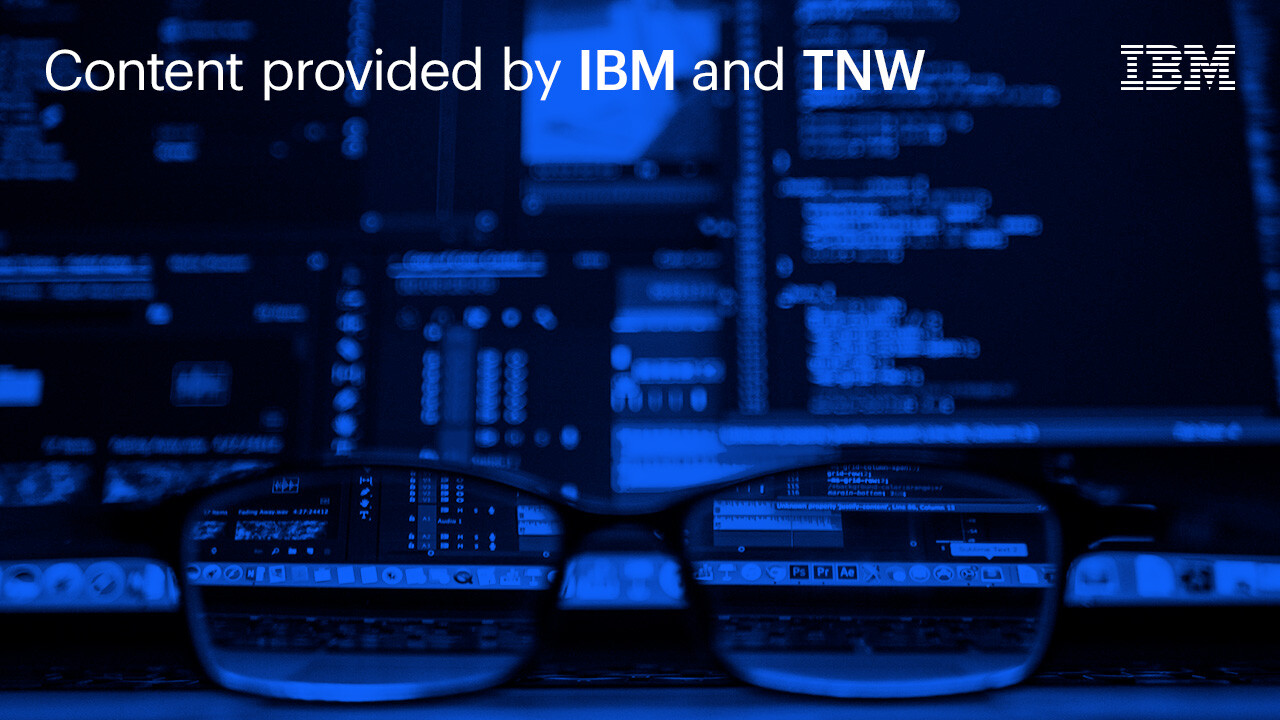
Content provided by IBM and TNW
Companies that don’t have a digitization and automation strategy will probably not survive in the next decade. Why? Because a host of technological developments are making it possible to free employees from a range of routine operations, so they can focus on the most impactful areas of business.
Enterprises that embrace automation can have happier customers, more satisfied employees, and streamlined operations. From back-office tasks to the inspection of industrial complexes and manufacturing sites, there are tools and platforms to collect and analyze various types of data, and take actions that automate repetitive tasks that previously required human effort.
In the past two years alone, ten years’ worth of digitization has occurred across different industries as more organizations realize the need to automate their operations. This should be an alarm bell for those who do not yet have a digitization/automation strategy.
However, the huge opportunity for automation comes with its own challenges. The growing number and variety of tasks that can be automated need careful oversight and planning. This is why you should consider appointing a Chief Automation Officer (CAO), a person who will be able to trace your enterprise’s digitization and automation strategy, provide a birdseye view of the digitization journey, and make sure that your enterprise is on its path to success.
The underlying technology
The appeal of automation has been around for a long time, and enterprises have been looking for ways to automate routine tasks. But there are a few recent trends that have lent to the explosion of opportunities for automation across industries.
“Artificial intelligence is clearly a trend,” says Dinesh Nirmal, General Manager at IBM Data, AI and Automation. “It can help with intelligent automation, whether it’s IT or line of business.”
AI is helping automate a broad range of tasks, from processing images and scanned documents, to summarizing text documents, finding meaningful correlations and clusters in large datasets, and transcribing audio files.
Enterprises are also using AI in IT operations, typically called AIOps, including anomaly detection, event correlation, and blast radius evaluation in case a service component becomes unavailable.
An interesting example is logistics and transportation company J.B. Hunt, which used IBM Turbonomic software to automate the scaling of its cloud and on-premise computing resources. For their on-premises environment, J.B. Hunt is automating all non-disruptive actions 24×7 and scaling non-production actions during a nightly maintenance window. In their public cloud environment, the team has been using a combination of recommendations and automated actions to manage their resources.
Digitization cannot happen without automation.
Over the course of 12 months, Turbonomic executed nearly 2,000 resizing actions which—assuming manual intervention requires 20 minutes per action—freed up over 650 hours of the team’s time to focus on strategic initiatives.
“Another technology is robotic process automation (RPA),” Nirmal says. “In line-of-business, a lot of technology that is being driven for automation is task related.”
If a task requires long hours of manually entering data and pressing buttons, there’s a great chance it can be automated through RPA. Today, organizations are using RPA to automate a wide range of repetitive back-office tasks, such as extracting information, moving files, and filling forms. The combination of RPA and AI is helping organizations take automation to higher levels and handle tasks that cannot be defined with explicit rules.
For example, insurance companies are using AI and RPA to automate the processing of customer reports. An application that previously took weeks to complete can now be processed in hours, thanks to RPA and AI technologies. One way is with computer vision algorithms that can assess damage from a picture of an accident and document processing tools that can extract and store the content of scanned documents.
A fourth notable trend that Nirmal talks about is “process mining.”
Process mining is about figuring out which processes are ripe for automation. What is the ROI if I were to automate this process? How much do I save in terms of time and resources by automating that process? What other touch points does the process have?
Process mining uses information from business and IT systems and user interactions to provide factual insights about how processes and workflows can be improved across an enterprise. For example, if delivering software requires several actions and file transfers across different platforms, process mining helps organizations document those steps, build them into a graph, monitor their performance, and find ways to optimize and improve them.
An interesting case study is BlueShore Financial, a Canadian credit union that partnered with IBM to digitize and automate its operations. At first, IBM helped BlueShore digitize the files of 40,000 clients and go entirely paperless, saving the company 7,000 square feet of filing space. The digitization then led to the automation of complex workflows and business processes related to onboarding, mortgage renewals, auditing, and more.
What is the role of the Chief Automation Officer?
“Automation helps with every single aspect of enterprise operations,” Nirmal says. “This is why every enterprise needs a Chief Automation Officer to focus on digitizing the enterprise to satisfy customers and help generate more business.”
Nirmal compares the role of the CAO to the Chief Data Officer (CDO). Before the CDO, organizations held an ambiguous volume of data, scattered across different silos and systems. The CDO’s role was to devise the right tools and strategies to provide a unified view of the organization’s data. The CDO became pivotal in areas such as business intelligence, data science, and machine learning, which need to pull and process data from different sources across the enterprise.
It can really improve employee morale and productivity.
Likewise, the CAO takes an overarching view across different verticals of the enterprise and seeks the best opportunities for digitization and automation. For example, in manufacturing, the CAO can help identify how computer vision can help automate defect detection. In financial services, the CAO can help find the right combination of tools to automate repetitive back-office tasks. According to Nirmal:
An enterprise is usually a big setup of complex processes across business and IT. We need a person who works collaboratively with the chief transformation officer, chief strategy officer, chief data officer, and others to bring digitization to the forefront. I believe that the CAO’s focus needs to be on digitizing the enterprise. Digitization cannot happen without automation.
Automation is finding its way into every department. According to IBM’s Global AI Adoption Index, companies are using automation across different verticals, including IT processes, business processes, marketing and sales, financial planning and analysis, etc.
At IBM, Nirmal has helped several customers transition through the digitization and automation process and understand the value of appointing a CAO. He sees three common denominators in the benefits that these organizations have achieved.
One is the optimization of resources within an enterprise. Two is productivity—I truly believe it drives a huge amount of productivity in the enterprise that you cannot get otherwise. And three is observability of your enterprise end-to-end, and how you’re digitizing your enterprise across different sectors.
The human side of automation
Nirmal says, “I think automation brings an enterprise into a much more stable format that will enable them to become more agile, allowing them to do more meaningful work.”
For example, from an employee productivity perspective, the right automation tools can lift the burden of repetitive tasks and enable employees to focus on more meaningful endeavors, such as innovation.
“A lot of times, automation allows employees to focus on higher value tasks,” Nirmal says. “For the employee, the huge benefit is that it releases them from routine tasks and frees them to look at things from an innovation or differentiation perspective. It can really improve employee morale and productivity, optimization, etc.”
But obviously, the biggest goal that every enterprise will have to focus on is improving customer satisfaction.
“The end product is how you help create satisfied customers. For me, to achieve that you need automation,” Nirmal says.
He sees this as the future of the enterprise, which will make the Chief Automation Officer role key to success.
The next decade is all about intelligent automation. Enterprises will have to invest in automation to survive and succeed, or they may not exist. It’s a profound statement, but I think it’s critical because your competition will invest in it. It drives customer satisfaction. If you don’t have satisfied customers, you are clearly not in a position to win.
Get the TNW newsletter
Get the most important tech news in your inbox each week.






